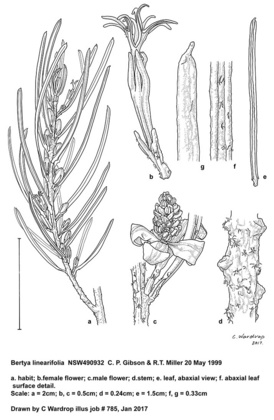Bertya linearifolia Halford & R.J.F.Hend. APNI* 
Description: Monoecious shrub; branchlets angular, becoming terete with age, sparsely stellate-hairy; hairs shortly stalked.
Leaves petiolate, spirally alternate, petioles 1–1.5 mm long, glabrous; lamina linear, 12–18 mm long, 1–1.3 mm wide; upper surface green, glabrous, ± smooth; lower surface white, very sparsely to densely stellate-hairy; apex acute, shortly apiculate; base cuneate; margins recurved to midrib concealing lower surface, with a small gland either side of midrib near base of lamina.
Flowers axillary or sometimes terminal, solitary; peduncles 2–3 mm long; bracts 2–5, 1–1.8 mm long, rounded at tip, glabrous, persistent or caducous. Male flowers sessile or pedicellate, pedicels up to 1 mm long; calyx lobes 5, oblong-elliptic, 3.5–4 mm long, 2–2.3 mm wide; androecium 2.7–3.2 mm long; stamens 25–35. Female flowers pedicellate; pedicels 2.5–5 mm long; calyx 5-lobed, lobes equal, erect, linear-ovate or linear-oblong, c. 2.5 mm long; petals absent. Ovary c. 2 mm long glabrous; styles shortly united for c. 1 mm; limbs 3, ascending, deeply bifid or trifid.
Capsule 8.5–10 mm long, glabrous.
Flowering: July.
Distribution and occurrence: Confined to the Denman-Sandy Hollow area. CWS. Found on a ridge with eucalypts.
NSW subdivisions: CWS
Text by D. M. Crayn
Taxon concept: D. A. Halford and R. J. F. Henderson (2002)
APNI* Provides a link to the Australian Plant Name Index (hosted by the Australian National Botanic Gardens) for comprehensive bibliographic data
***The AVH map option provides a detailed interactive Australia wide distribution map drawn from collections held by all major Australian herbaria participating in the Australian Virtual Herbarium project.
|


